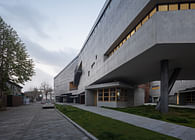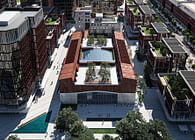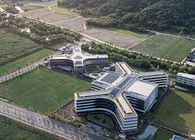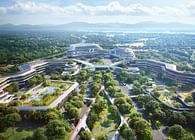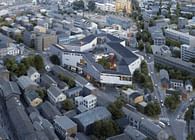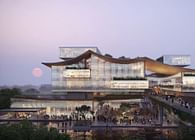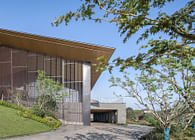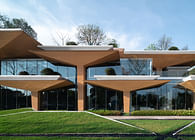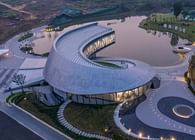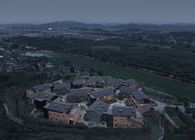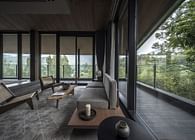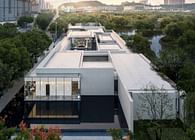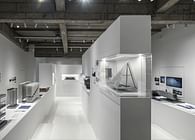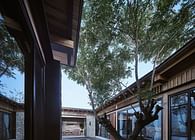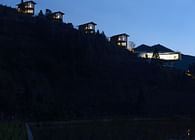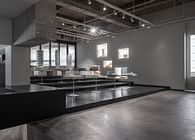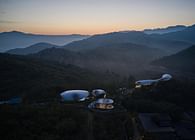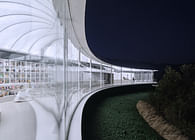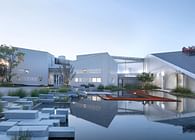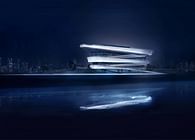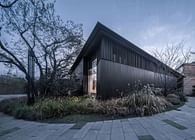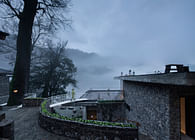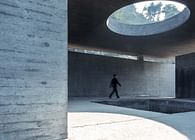
Different from the single functional appeal of traditional office buildings, corporate headquarters is a complex space integrating R&D office, corporate image display, brand value transmission, and even stimulating staff exchange and cooperation. The competition of market economy is more and more fierce, and more and more large and medium-sized enterprises are engaged in the construction of their headquarters, which constitutes a new element of soft power competition. From the perspective of architectural design, how to use architecture and space language to customize the image and temperament of the enterprise, how to reflect the value of the enterprise in each stage from space planning to detail construction become our thinking of enabling this type of field.
——Fanhao Meng
Viewshine is a high-tech enterprise specializing in intelligent gas meters, which was listed in 2017. The owner, by chance, was driving through the Hangzhou Xixi Green Office Complex, and had a high resonance for its formal aesthetics and architectural quality, so she contacted us and entrusted us to complete the design of its new headquarters.
Like the vast majority of non-real estate industry owners, when commissioning the design, the owners only gave some vague imagination about the future headquarters of the company, but did not put forward clear demands. With the continuous deepening of communication with the owners, we gradually realized the pursuit of practicality, economy and quality of industrial intelligent manufacturing enterprises, and the intention to find their own positioning vision in the rapid development of the Internet city, "practicality", "precision", "economy" and other keywords began to emerge. We translate the abstract appeal into architectural language, so that the architecture will return to functionalism, abandon the complicated skin appearance, precisely refine the space details, infiltrate the sense of science and technology with the Times, and gradually form a differentiated image of the listed industrial intelligent manufacturing company.
The client gave us a high degree of trust and freedom without the help of external design controls. After four years, under the integrated cooperation of architecture, interior, landscape, curtain wall, structure, electromechanical and other teams, Viewshine Headquarters has been successfully launched.
#01
Volume Strategy: Separation
The base is located in the former Shangcheng industrial park of Hangzhou, which was founded in 1993, and has gathered a large number of high-tech enterprises, among which Viewshine is one. The plot covers an area of 8,599 square meters, has a plot ratio of 2.5, a density of 30%, and a height limit of 50 meters. The shape of the plot is a rectangle with an east-west longitudinal length-width ratio of about 2:1, intermixed with the complex environment of industrial plants, offices, natural landscape and urban life.
The west and north sides of the plot are oppressed by high-rise buildings, resulting in cramped space; The south side is bordered by the city branch road, becoming the main direction of flow of people; The east side, facing the tributaries of the canal, is the only open interface. The distinctive site features give rise to the starting point of the design. We try to find the appropriate design strategy to respond to the site and transform the site features into the characteristics of the building itself.
"Separate Traffic Core" was the final spatial layout strategy we adopted to respond to the site in the most direct way. Considering the vertical traffic, toilet, equipment room and other auxiliary functions as a whole, the pure service volume is arranged on the west side of the site, and the inward "black box" solves the negative conditions on the west side of the site. The office volume opens outwards as the "white box" facing the landscape on the east side. Finally, a 50-meter-high shared atrium is inserted between the two large volumes, connecting and separating them, and opening to the city with a transparent boundary.
In fact, the generation of the form has established the corresponding isomorphic relationship among the three elements of "site-volume-function". It means that the functionalist architectural space is embedded in the specific site, which forms the basis for the rationality of volume strategy. The correspondence between function and volume also gave a clear, simple and orderly floor plan, which initially established the temperament of the headquarters building.
#02
Formal Strategy: Abstraction
After determining the isomorphic relationship of "site-volume-function", further deepening the concrete exterior form, interior space and skin texture of the building, excavating and developing the unique temperament of the enterprise itself, and translating it into an abstract form language, is also the key step to reach a resonance with the owner in the design stage.
The panoramic view and extremely high spatial flexibility are the biggest spatial features of the east office volume stripped of auxiliary functions. We maximize the mapping of these two features into the facade image and spatial experience, and serve as the main façade of the headquarters building.
The rectangular office volume was lifted to the second story, and cantilevered overhead on the south, east, and north sides of the ground floor, creating a complete interface and large-scale public area unencumbered by the building, enhancing the ground floor's openness.
The proportion of the east façade of the volume is approximately 4:3 under the supervision of the height restriction, and the image is excessively stiff. Simultaneously, the regular rectangular space is too boring, so we combined vertical and horizontal development, placing a continuous zigzag cantilever platform through the 4-10 floors of the east façade, not only as a vertical scale division of the façade, but also as a plane extension of the air communication space.
The auxiliary volume on the west side strengthens its internality in form deepening, and is designed to stagnate southward and rise above the office volume on the east side. While enclosing the ground floor entrance plaza, the unbalance between the volumes creates dynamic forces and is clad in dark metal perforated panels, creating a posture of resistance to the negative west side of the headquarters building.
The 50-meter high atrium introduces vertical skylight, which not only establishes a dialogue relationship between east and west volumes, but also forms a fuzzy boundary between indoor and outdoor. Glass boxes with meeting and negotiation functions are placed in each floor to create multi-dimensional layers for the internal space.
A set of huge steps connects the first floor of the exhibition hall to the second floor of the staffs’ house, serving as a structural link as well as multi-functional areas. In addition, the entire room may be used as a huge lecture hall.
In the process of giving forms to different spatial volumes, on one hand, pragmatism is upheld to enrich the architectural function while deepening the form; On the other hand, the form distinction between the volumes gradually reflects the clarity of formal logic, further strengthening the connection between architectural character and enterprise temperament.
#03
Construction Strategy: Collaborative Integration
We prefer architects to use the word "build," and the best architectural products come from "the art of building."-Ludwig Mies van der Rohe
Based on years of practical experience, we always regard construction as one of the core contents of our thinking and work. We firmly believe that abstract formal language has real meaning only when materials and details are carefully considered.
3.1 Structure, Mechanical and Electrical Cooperation and Integration
The height limit of 50 meters and the space of 6 meters on the first floor will compress the standard floor height to 3.9 meters, which is less than the design height of normal office buildings. How to improve the net height of the core space under the condition of high height and large span is a big challenge we are facing in deepening the design. In close collaboration with the structural and electromechanical designers, the maximum structural beam height was determined to be 700mm, and the larger equipment pipelines were arranged along the edges to achieve the net height of 2.9 meters in the core office space and 2.6 meters in the walkway and other secondary spaces, reaching the net height of 4.2 meters in the conventional office building.
Furthermore, the east volume's double column design guarantees that the workplace area is open and flexible with no boundaries. A cylinder structure is placed at both ends of the north and south, and the steel structure is converted by the diagonal support column structure at the second and third floors to satisfy the shape need of 10 meters cantilever in the north and south's first floor. Throughout the design process, we discussed with the structural designer whether the structure should be transformed using the diagonal brace or the cable-stayed, and eventually decided on the shape of the diagonal brace to reduce the transformation structure's influence on space usage.
3.2 Façade Construction
Under the premise that the cost is strictly controlled, we are still committed to creating exquisite and durable façade details to show the characteristics of the owner as an intelligent manufacturer of precision instruments.
The design first grasps the economical pragmatic attitude, abandons the decorative component. The design adopts the conventional methods of curtain wall transition and horizontal and vertical louvers to cut down complexity and simplify. The unitary glass curtain wall forms a clean and flat facade, and the detailed structural design at conventional cost forms an unconventional visual focus and architectural image.
By rationally arranging the white glazed dots, the white gradient glazed glass curtain wall creates an unusual skin, developing its own character in the surrounding metropolis. The glaze dots gradually diffuse from the upper and lower ends of the glass to the middle part of the human visual field, effectively reducing energy consumption while having no effect on the indoor visual field, while the exterior will show a variety of opaque, translucent, and transparent states as the visual angle changes.
In the early stage, we thoroughly examined the glaze dots through a large number of pattern studies and 1:1 printing, in order to save the time and economic cost. The on-site mock-up produces the intended impact at one time. Glazed glass skin adopts the construction technology of unit curtain wall. Standardized manufacture and installation aid not only in the monitoring of construction site accuracy, but also in the reduction of construction time costs, which also reflects the advantages of industrial intelligent manufacturing in the construction.
The building skin for the volume of the west service is black perforated panels, and the rough heavy metal texture contrasts sharply with the delicate glass block, which are heavy and light, solid and translucent. The materiality of the dark perforated volume necessitates perfect uniformity between the inside and exterior of the structure, and the integrated design of the architecture and interior plays a decisive role at this moment. We create a unified skin approach by extending the facade's material, structure, and form language to the interior. The border of a typical window opening in a perforated panel is carefully aligned with the horizontal and vertical structure of the curtain wall to avoid the negative impact of the horizontal and vertical structure of the curtain wall on functional space.
The hole shape and dimension spacing of perforated panels should simultaneously satisfy the indoor ventilation and lighting as well as the outdoor facade effect. After many times of comparison and selection of samples, the final group of data namely 12 mm round hole aperture, 8 mm spacing, 32.65% perforation rate was determined. The original 8 mm thick plate can achieve perfect flatness, but in order to control the cost, 5 mm thick plate and two back ribs were redesigned.
The elevator hall is located in the middle of the volume, and the line of sight is positioned between the two office buildings on the west side. We completely run it through the east and west, becoming the only viewing window of the perforated plate volume.
To accentuate the public qualities of the atrium space and lessen the barrier between indoor and outdoor, we used ultra-white high-transparency glass for the north and south sides of the atrium.
In order to successfully minimise the atrium's energy consumption, an electronic shade curtain is installed on the glass roof to increase the atrium's comfort in the summer. The drainage problem at the top of the vast glass atrium was overcome by a collaboration between architecture, structural, and curtain wall: The structure hole is reserved at the corresponding position of the glass roof of the atrium (the bottom of the parapet flanges), and the middle of the glass roof is slightly arched to look for slopes towards the east and west sides after lowering the elevation of the glass roof of the atrium to 48.9 metres, which is consistent with the roof elevation of the east and west building structures. Rainwater may run via the structural openings in the parapet and into the east and west towers' roof drains, making the volume's connection as clean and simple as feasible.
#04
Communication Strategy: Persistence and Compromise
The design process went quite easily because to the owners' strong conviction. However, as the project developed, the designers and owners had differing expectations about how the two areas should be implemented.
4.1 North Corridor in the Atrium
In the original plan, the north corridor is covered with perforated panels, while hanging stairs are set on floors 4-5 and 9-10. The designer considered that the north external features will cause visual interference to the spatial atmosphere when entering. But the owner felt that this would limit the atrium area too much. We did not compromise at first and attempted to persuade the owner, but the owner was under financial pressure throughout construction and thought that we could optimise the design to keep costs down. After re-simulating the area, we opted to remove the perforated skin as well as two outdoor steps.
Even after the completion of the project, I still simulated the original design effect in my mind when I was in the atrium. Although there is no problem with the starting point of the design from the perspective of spatial fun, however, in the actual space, due to the low viewpoint of the entrance hall, the visual angle is blocked by the corridor floor plate, and the visual interference of the external building is very small. If we stick to the original plan, the relationship between the dark perforated panels at the corridor and the perforated panels at the west side of the tower is ambiguous, which will weaken the volume relationship of the building, and also cause insufficient lighting in the atrium and space depression. The compromise turned out to be a design correction caused by the owner's cost pressures.
4.2 East Step-Like Space nearby the River
The second place is the stepped space facing the river on the east side. The external shared terrace extends to the interior, forming a coherent shared space with double height inside and outside, which is an important part of the integrated design. However, in the later stage of construction, the owner required to cancel the interior double-height design for the convenience of future divided rental management. Due to the economic pressure of construction and understanding of the owner's demands, we finally cancelled the double-height space here. This is also the only regret in the design of this project.
Any project will inevitably compromise in the process of design and construction. Sometimes the owners' demands will positively correct the design, and sometimes the changing reality will cause certain damage to the design. When there are differences, architects might as well take a rational and comprehensive consideration from the perspective of owners and users. A certain degree of compromise is also the professional quality of our architects in dealing with professional work.
#05
Integration Strategy: Control
Viewshine Headquarters is our attempt to complete the integration strategy of the project. The integration strategy of architecture, interior and landscape not only connects the architectural form language, functional layout and spatial atmosphere, but also runs through the whole project cycle. The tacit understanding formed in the continuous communication with the project owner makes it easier for us to capture the owner's appeal and translate it into space. While reducing the communication cost, we can also save the actual construction cost and implement the design concept with high quality.
5.1Counterpoint of Plan Function
An unavoidable problem in the design of corporate headquarters is the repeated adjustment of office areas. For this reason, after the auxiliary functions were stripped to the west volume in the early stage, the interior design dealt with the uncertainty of office division by establishing a clear strategy of functional areas. Public facilities such as lecture hall, cafe, exhibition hall and gym are centrally set on the 1st and 2nd floors to ensure accessibility and improve later management and operation efficiency.
Except the top floor where the company's senior executives work independently, the standard office floor adopts the mode of "large proportion of open office + small proportion of independent office", and the glass curtain wall on three sides and the ultra-white glass on the side of the atrium provide sufficient lighting. This minimizes the impact of office zoning changes on design and schedule.
5.2 Precision of Module Application
The curtain wall unit's module is used for the metal mesh ceiling plate in the office space, as well as the partition of tiny spaces and the landscape pavement in the entry square. The module not only controls the quality of internal and exterior space, but it also reflects the enterprise's accuracy and orderly character.
5.3 Blurring of Space Inside and Outside
The atrium not only unifies the interior and outdoor facade implemented by the curtain wall unit, but also integrates the outdoor experience into it. With the help of clear glass, employees are inspired to communicate in shared spaces and enjoy natural views in sky courtyards.
The interior design also conforms to the characteristics of the eastern and western volumes in terms of atmosphere. Inside the dark perforated panel volumes are dark meeting rooms, lecture halls and auxiliary spaces with industrial feeling, with a calm tone. The glass volume is a plain white office area with a bright tone. Indoor materials intersperse with each other in contrast, the scene is changeable, but the space is continuous.
Conclusion
During the nearly four years from the design, construction and final completion of the project, what we have communicated with the owner repeatedly is not only the design concept and technical solution, but more importantly, we help the owner of non-architecture background to understand the architectural language, integrate demands, and gradually describe his architectural imagination. This has laid the foundation for the same value recognition of both parties. With architectural design as the leading, we provide a bottom-up design path, and cooperate with all parties to promote the better development of the project. "Effective communication" has gradually become an important skill for us in the face of non-professional owners.
Now, new headquarters building of Viewshine has been completed. Despite the lack of standing out heights, dramatic styling, and expensive skins, we have overcome technical difficulties and created a unique architectural quality that makes the work stand out as an identity within the surrounding area through practical architectural functions, unconventional texture design, precise detailed construction, highly integrated internal and external space, strictly controlled architectural quality, under relatively conventional cost control.
We believe that good design is not only the creation of passion in the face of the site, but also rational thinking and continuous correction under objective conditions. Within the common value framework with the owner and the cooperative team, we control each link with scientific methods, analyze, explore, study and elaborate, and establish the internal logical connection and balance between various elements.
Status: Built
Location: Hangzhou, CN
Firm Role: Architect & Interior Designer & Landscape Designer
Additional Credits: Project Name: Viewshine Headquarters
Location: Hangzhou, Zhejiang
Design Unit (Architecture): gad, line+
Design Unit (Interior, Landscape): line+
Chief Architect/ Design Principal: Fanhao Meng
Project Leaders: Xinguang Li (Architecture), Jun Zhu (Interior), Shangyang Li (Landscape)
Design Team: Xinguang Li, Guangwei Huang (Architecture), Jun Zhu, Hao Deng, Zhenliang Ge, Sisi Zhang, Limin Qiu, Wen Chen (Interior), Shangyang Li, Jianbo Jin, Xiaomei Chi (Landscape)
Structural Electromechanical Design: Zhejiang Greenton Architectural Design Co.,Ltd
Design Team: Yingdong Wu, Xuefeng Wu (Structure), Daliang Cui, Yuanyuan Fang (HVAC); Wenjian Wu, Bin Zhang, Yaxuan Zhao (Water Supply and Drainage); Xiaojing Lao, Rong Liu (Electrical)
Curtain Wall and Lighting Consultant: Shanghai Eduth Facade Consultants Co., Ltd.
Floor Area: 31,914.01 square meters (2,1497.49 square meters above ground, 10,416.52 square meters underground)
Design Time: 2017/07-2020/12
Construction Period: 2018/08-2021/12
Client: Viewshine Ltd.
Structure: Frame - Shear Wall Structure
Material: White Gradient Glazed Glass, Dark Perforated Aluminum Plate
Photography: shiromio, Aaron&Rex, Xi Chen







